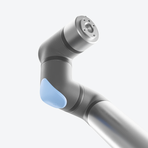Forty years ago, factory automation was all about getting labor out, replacing operators, welders and assembly line workers with robots. Today that equation is as antiquated as a horse and buggy. Today the focus is on boosting productivity and increasing flexibility on the floor to produce more products quicker.
What changed? The labor crisis in manufacturing has had a profound impact on factories large and small, as companies struggle to fill job openings and retain their current employees. Today the challenge is to increase production with a limited pool of skilled workers who want a career in manufacturing.




